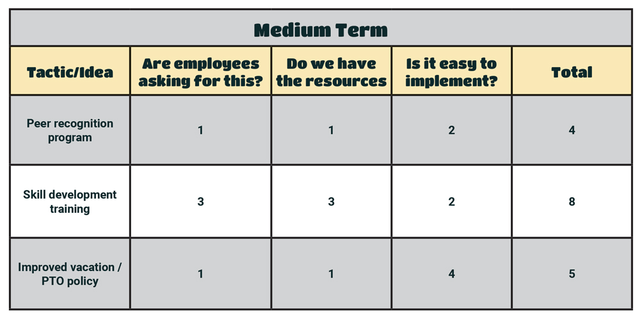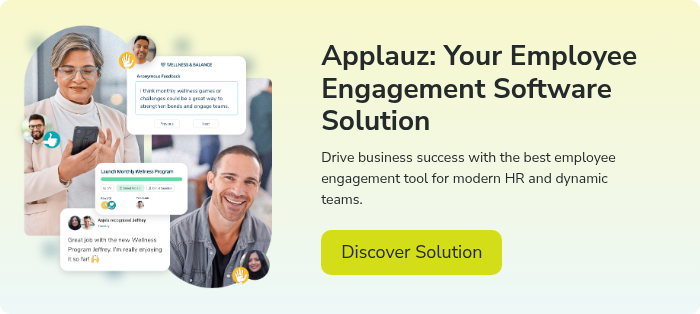In any business, there are always competing priorities. Recruiting and hiring are expensive and ultimately take up the majority of Human Resources time and resources.
Consequently, employee retention takes a back seat. How does this affect the business and its people?
- Benefits and perks for attracting candidates are given priority.
- Retention efforts are only considered if there is an obvious problem, like high turnover or low morale.
- Initiatives are put in place without exploring the root of the issue or taking the time to ask employees their opinions.
Retention can be proactive, not reactive

The problem with this approach is that it's reactive. But it doesn't have to be this way. You can proactively work on creating lasting value for your employees as well.
If your business wants to build a strong Employee Value Proposition (EVP) that not only attracts but retains employees, it must prioritize strategic employee retention.
As hard it can be for budget-conscious business leaders to hear, this means freeing up or creating more resources in HR to actively work on these initiatives.
Secondly, your business must think carefully about the ideas it chooses to implement.
Suppose this step is neglected in a hurried attempt to solve a problem like high turnover. In that case, you risk making the situation worse.
In contrast, being strategic means recognizing how your offering fits into the bigger picture of your employees' needs at every stage of their life cycle. And also the larger vision for your employer brand.
Of course, some HR teams may have modern retention tools to help them be more objective in their decision-making. However, many smaller companies don't have access to such tools.
For those smaller HR teams crunched for time, this framework and system will allow them to develop a strategic plan quickly.
What does a strategic plan look like?
A few important factors need to be considered before implementing any idea. To adopt a strategic approach to retention, you should ask yourself the following questions:
- What role does this initiative play in the larger picture?
- Which employees will benefit most from it?
- How feasible is the implementation?
- How will we promote this initiative?
That said, after reading this article, you will:
- Have a template to build your employee retention plan.
- Have the task of “improving retention” broken into smaller, more digestible steps.
- Understand what drives employee loyalty at each stage of the lifecycle.
- Be able to audit and identify gaps in your current retention strategy so you can select future initiatives in a strategic way.
Let's get started!
A Simple Step-by-Step Guide for Planning Your Employee Retention Strategy

Step 1 - Document your company’s EVP
To kick-start your strategy, you must first look at your company’s current Employee Value Proposition (EVP).
Remember: Your company’s EVP includes both tangible and intangible benefits employees receive when working for your business.
You can classify these benefits by breaking them down into five broad categories:
- Compensation (i.e. salary, pay raises, bonuses, profit sharing)
- Core Benefits (i.e. health care, vacation, time off, remote work)
- Work environment (i.e. Work-life balance, autonomy, psychological safety)
- Career (i.e. promotions, training, coaching, mentorship)
- Culture (i.e. Mission, values, prestige, social responsibility)
To tackle retention systematically, documenting your EVP is only the first step. You have to consider your EVP from the perspective of the entire employee lifecycle -- in the short, medium, and long term. In other words, what’s important to a new employee is not necessarily what’s important to an employee with a tenure of 5-years.
This next section will go over each and give examples to understand how it's important in the larger picture.
Short-Term: The things that initially attract talent
Short-term factors are the baseline value you offer to workers. These benefits serve as the foundation of your EVP. They will help attract candidates but also keep them for the short term.
For example, a 2015 study showed organizations with a strong onboarding process improve new hire retention by 82% and productivity by more than 70%.
Short-term retention factors include:
- Competitive salary
- Modern office in a central neighbourhood
- Flexible hours and remote work options
- Basic benefits (e.g. health plan)
- Attractive vacation policy
- Fun perks like free cereal and game rooms
- Social events (e.g. yearly offsite)
- Onboarding package (e.g. company swag, gifts, laptop etc.)
These offerings create attractive packaging. They are the things you mention in your job postings to draw people in. And they are surely appreciated by the current staff as well. There are, however, many other factors that can create loyalty as time progresses
Medium-Term: The things that give people a reason to stay
Think about working from an office in a trendy neighbourhood or having a competitive salary. It must be nice! Right?
Yet, suppose your boss is rude, or your coworkers are always spreading negative gossip. In that case, you will likely develop a negative feeling about your job regardless of the office's location or the size of your paycheck.
In other words, our daily experiences shape the way we feel about our work. That's why in the medium-term intangible factors start to come into play as well.
Retention factors in the medium-term include things like:
- Yearly salary adjustments
- Strong coworker relationships
- Job shadowing, mentorship opportunities
- Programs to help employees feel appreciated and recognized. (i.e. years of service program, recognition programs)
- Mental wellness programs
- Skill development training, learning stipends, feeling challenged
- Advanced health benefits (e.g., childcare, psychological services)
- Supportive managers and psychologically safe environments
These programs and benefits encourage employee commitment for some time, perhaps a few years. So what drives long-term commitment; the kind that lasts for several years or even decades. Companies need to provide long-term value and rewards. By doing so, employees will remain internally motivated to work towards and look forward to something greater.
Long-Term: The factors that drive long-term commitment
Certain benefits are highly effective short-term motivators. For example, a bi-weekly salary, access to a health plan, working on challenging projects.
In reality, these are essential benefits. In short, many companies offer them. As such, these benefits aren’t as effective in sparking the type of internal motivation that compels people to work somewhere long-term.
Take a moment to consider: What does your company offer as long-term incentives?
Retention factors in the long-term include things like:
- Professional career growth (official promotions) or role switching
- Tenure-based bonuses
- Performance-based bonuses, profit sharing
- Tenure-based vacation, sabbaticals
- Retirement matching, 401k matches
- Equity in the business (e.g., stock options)
- Collective re-set weeks (mandated office closing)
- Inspiring mission
- Social action or contributions to the community
- Values alignment
- A strong belief in the product and future success of the business
As you can see, these factors can be intangible factors such as the prestige of your brand and an inspiring mission. Or more tangible benefits like a tenure-based sabbatical.
Bottom Line: Employees will be more likely to stay long-term if they have a vested interest in the company, if the company's values align with their own, or if they are guaranteed rewards they can strive for and expect.
Step 2 - Audit your current offering
We have now explained how the elements of your EVP can be used to create short, medium, and long-term value for your employees.
The next step is to do an audit of your company’s offering.
Pinpoint your company's offering at each stage
You can start this exercise on paper or a shared digital document. Simply create a table with three columns “short-term, medium-term and long-term.”
.png?width=480&name=image%20(28).png)
Look at the elements that make up a company’s EVP (e.g. compensation, benefits, work environment, etc.). Under each column, write what your company offers for each.
Pro Tip: You may want to consider making one for each department. Certain benefits like “competitive salary” might apply to one department and not another.
Identify the gaps
Once you are done filling out each column, what do you notice...
- Is one column sparse?
- Do some columns seem to have more content than others?
For example, does your company seem to offer a lot of short-term value with attractive perks but little value in the long-term?
The gaps should naturally jump out at you.
That said, if you've been in your company for a while, you might already be well aware of the gaps. In other words, you know what your EVP is missing. You've already collected this feedback from various channels, such as employee complaints and exit interviews. So this exercise may seem unnecessary to you.
However, we strongly recommend putting everything your company offers on paper. It's a great first step to planning your strategy, and when do you ever have a global view of your core EVP?
Step 3 - Crowdsource ideas to develop your plan
Many HR teams find this to be the most challenging part of their work. This process will, however, make it easier.
First, this process breaks down the intimidating task of "improving employee retention" into smaller, more easily digestible steps.
Additionally, you will crowdsource ideas from your colleagues, company managers, and employees. Ultimately, these programs and benefits aren't for HR; they're for employees! This means they should embrace every idea, too.
Speak with coworkers & managers
By documenting your core offering and outlining the gaps, you will be in a better position to receive feedback from your colleagues.
We recommend that you speak with company managers or employees who have a strong connection with frontline workers.
They can help identify where your retention efforts are successful and where they are falling short. Frontline managers will surely have insights to offer. They understand the day-to-day grievances of the average employee.
Pro Tip: You might also consider investigating the EVP of similar businesses in your industry. How does your EVP stack up against theirs?
Speak with your employees
A critical part of developing your retention strategy is to speak directly with your employees. Ultimately, the programs and initiatives you are considering are in service to them, so it’s critical to understand if they will benefit from those programs and initiatives.
A few common ways to collect feedback on specific topics:
- You can send out an anonymous survey to ask employees how they feel about your companies perks and benefits. And ask them to give your company feedback about any perks and benefits they feel are lacking.
- Focus groups can be used to gather feedback on your employees' perks and benefits. Pick a few participants at random from each department.
Alternatively, your company may already be using Pulse Surveys or an ongoing survey tool, so you may already have some insights stored. This employee feedback data should be used to generate more ideas for your plan.
Document your ideas
At this point, you should have crowdsourced many ideas from speaking with colleagues, employees, and managers.
After you've investigated deeper and have gathered feedback, the next step is to document these new ideas that have come from your research.
The bulk of the work has been completed. However, it's not over just yet! Now you have to ask yourself an important question: which ideas should take priority.
This brings us to our final step...
Step 4 - Refine ideas and finalize your action plan
Evaluate your ideas systematically
Your next step should be to sort through your list and prioritize the most important ideas and initiatives. However, you can't just rely on your intuition to decide what is most important.
You can easily achieve this with a simple scoring system.
If you want to be strategic about retention, this step is critical. This approach helps you remain objective and determine which initiatives are most worthwhile and urgent.
Ideally, you want to judge each idea based on a few fundamental factors:
- Business need: Consider how valuable this idea is to your employees and the company at large. (i.e., are employees asking for it, does this benefit make us more competitive?)
- Resource availability: Can this idea be realized based on the available resources (i.e. time, money, etc.)
- Ease of implementation: Think about factors like how long it will take and whether multiple approvals will be required.
Your table can look something like this:

You are welcome to add any criteria you think necessary to evaluate each idea.
On each criterion, give a score of between 1-3. The lowest score of 1 signifies you “strongly agree,” and the highest score of 3 means that you “strongly disagree.” Calculate a final total score for each idea.
Priority should be given to ideas that satisfy a business need, require a reasonable investment of resources, and are easy to implement. In the example above, that would be a Peer Recognition Program.
Of course, this doesn’t mean you should ignore any ideas that are more difficult to implement. However, these are the ideas you might want to save for a time when you have more resources available.
Final Thoughts
Too many businesses launch HR initiatives or programs only for employees to fail to use them. In many cases, employees don't even know they exist!
This unfortunate outcome happens when companies put employee retention on the back burner. Initiatives are rushed and end up poorly thought out. Worse, they are not properly promoted. This reactive approach makes it difficult for any company to build a strong employer brand and EVP.
This article presents HR teams with a solution: A framework to assist their planning efforts. By using this framework, HR teams can stay focused on the big picture, and as a result, come up with strategic and worthwhile ideas.
Ultimately, your HR initiatives will be meaningful. They will dig deeper and create real, long-term value that inspires employees to remain loyal for years to come.
About the author
 Michelle Cadieux
Michelle Cadieux
Michelle is a content writer for Applauz. She holds a Bachelor's degree in Psychology from Concordia University, and she has been writing about work and employee happiness for over five years.





